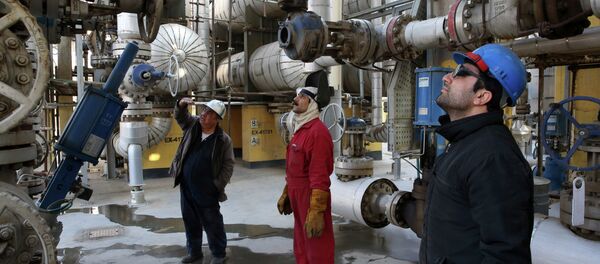OPEC members and key oil producers from outside the cartel are set to meet in Qatar’s capital Doha on April 17 in a bid to stabilize plummeting crude prices.
The Qatari oil minister and current OPEC President, Mohammed Al Sada said in a statement that 15 countries accounting for some 73 percent of global oil output supported further action.
Meanwhile, let’s have a look at the system which underlies the standardization of oil prices and the fate of those countries who once wished to abandon it.
The Empire of the Petrodollar
Soon after the collapse of the Bretton Woods gold standard in the early 1970s, when the US unilaterally abandoned the Gold Standard which pegged the value of the dollar to the price of gold, and all other currencies were pegged to the dollar, the US struck a deal with Saudi Arabia to standardize oil prices in dollar terms.
Kissinger may have sealed a deal whereby Saudi Arabia would formally and solely accept dollars for all its oil sales, and would exert its power over the Arab region to ensure other Gulf exporters did the same.
Saudi Arabia would then make available and place "surplus liquidities," unspent dollars, in the US Federal Reserve system, starting with the Federal Reserve Bank of New York.
https://t.co/sx87lWLIS7
— deepaksekar (@Deepak__Sekar) 25 марта 2016 г.
It is worthwhile to consider about International clearing union and Bancor prosoped by John Maynard keynes.
The petrodollar recycling system thereby elevated the US dollar to the world's reserve currency and brought massive advantages to the US.
Worldwide, any buyer and importer of Arab oil would first need to buy and hold dollars, ensuring strong global demand for the US currency.
Secondly, the surplus or unspent dollars that each state would accumulate in its national treasury would needed to be "recycled.”
This last point, is the most beneficial for the US dollar; as the petrodollars make their way back to the US, these recycled dollars are used to purchase US securities (such as Treasury bills), which creates liquidity in the financial markets, keeps interest rates low and promotes non-inflationary growth.
These "petrodollars" going straight into the Federal Reserve system, backstop the US dollar, and enable the strategy of "controlled devaluation," needed to help service growing US debt by devaluing the money used to repay loans, to operate without running out of control and turning into an inflation rout.
The Sad Fate of the Refuseniks
Yeni Safak recalls the unfortunate position of those member states who once attempted to get out of the system.
@millerniumtwit @28Pages Short of an invasion, the greatest threat to the Saudi monarchy would be de-dollarization of oil, ie. oil for food.
— Chris Tesi (@cmtesi) 26 сентября 2014 г.
Back in November 2000, Baghdad insisted on and received UN approval to sell oil through the oil-for-food program for euros. Iraq had threatened to suspend all oil exports — about 5 percent of the world's total — if the body turned down the request.
According to The Guardian’s report on the issue, “Saddam's Weapons of Mass Destruction was not really the issue — and neither was Saddam himself.”
In 2001, Venezuela’s ambassador to Russia spoke of Venezuela switching to the Euro for all their oil sales. Within a year there was a coup attempt against Chavez, reportedly with assistance from the CIA.
Back in 2009 then president of Libya Muammar Gaddafi was named the head of the 53-member body of the African Union.
According to more than one observer, Gaddafi put forward a plan to quit selling Libyan oil in US dollars, demanding payment instead in gold-backed “dinars” (a single African currency made from gold).
The regime, sitting on massive amounts of gold, estimated at close to 150 tons, was also pushing other African and Middle Eastern governments to follow suit.
Numerous reports suggest that in 2005-2006, the Tehran government developed a plan to begin competing with New York's NYMEX and London's IPE with respect to international oil trades — using a euro-denominated international oil-trading mechanism.
The clear aim was to establish a firm foothold of the euro in the international oil trade.
Now, as many more countries, including Russia, China, Saudi Arabia and others are talking of breaking free from the petrodollar system, their joint meetings become more and more intriguing.









